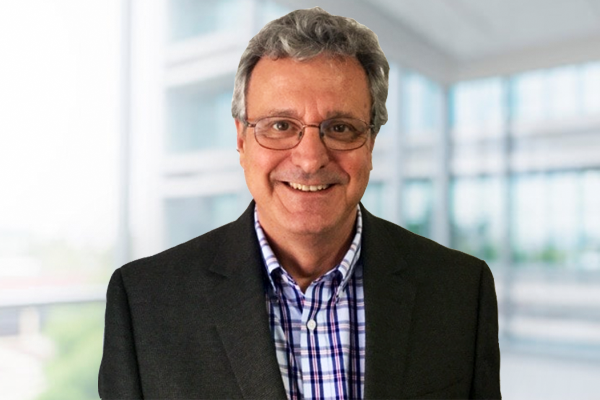
December 21, 2020
The Journey is the Destination – A Q&A With eMindful Teacher Roger Nolan
Like many early birds, eMindful teacher Roger Nolan wakes up between 5 and 6 a.m. He begins his day with a brief mindfulness practice, such as 10 minutes of stillness while he’s still in bed, and then it’s coffee and reading his two favorite newspapers online. And on weekday mornings, what comes next at 8 a.m. has become something meaningful and a little unexpected for him.
When California’s Stay at Home order was issued and the yoga studio where he’d been leading an in-person meditation practice had to close, Roger began leading a virtual weekday meditation for his students. Now nearing its 200th session with attendees from all over the world, Roger says he sees the impact and need for mindfulness even more during this challenging time.
“I was absolutely floored. People have come to really anticipate it, and to me, it’s a great privilege to be able to do this,” he says.
Roger has also been teaching multiple mindfulness programs with eMindful for the past six years, and we sat down together to talk about his personal mindfulness journey.
Q: How did you find mindfulness?
Roger laughs because, for him, it literally fell from the sky and he still has an artifact from the impact.
“I started meditating in 1973 at the University of Kansas and then practicing yoga a couple of years later. In the 90’s I started teaching yoga, so I was rummaging for yoga books in a bookstore called The Bodhi Tree,” he says.
“I jostled the bookcase and a book fell on me – it was ‘Wherever You Go, There You Are’ by Jon Kabat-Zinn, founder of the world-renowned Mindfulness-based Stress Reduction Clinic at the University of Massachusetts Medical School. A guy who was walking by said that when a book falls on you there, you have to buy it. I brought it home and started reading it, and it had a great resonance for me.”
Q: Do you have a favorite mindfulness practice?
“It has actually become loving kindness practice and I invoke it daily many, many times toward myself and others. It has become my go-to practice in terms of helping me cope with the anxiety and stress that I go through. I have always been an anxious person, and while mindfulness itself has helped, loving kindness has taken it to exponential levels.”
Q: You’re one of the teachers for Mindfulness At Work, correct? Can you tell me a little bit about that?
“It’s mainly about managing stress because we’re not going to be able to avoid stress or things that stress us, but we can learn to relate to it better and respond more skillfully to stress when it arises,” he says.
“This program also makes people more aware of how to know when they’ve become stressed and how to manage that through different practices or strategies, including those that are mindfulness-related.”
Q: How do you think stress in the workplace has changed over the past year?
“The 24/7 not leaving your house, especially if the kids are there too, adds an immense amount of stress. Many people are not just at work, they are also parenting and facilitating teaching…and the stress is mainly that they aren’t leaving home and are rubbing up against their spouses and kids all day,” he says.”
Roger explains that he believes people are “wonderfully resilient” but just as we all have limited energy reserves while we’re healing from an injury, the same is true of events that impact our mental health.
“People are hitting walls in their energy reserves; there’s lots of anxiety and depression, and we are undergoing a worldwide experience of trauma,” he says. “I really enjoy opening the door to my office and having the privilege of teaching mindfulness during this time. I love the work.”
Q: Let’s go a little off-topic for a second – what’s your favorite food?
“I enjoy food, but I am also a creature of habit. I am rather fond of Thanksgiving food. I also have a really good oxtail soup recipe that I cook in the slow cooker. My favorite food outside of the home is comfort food like fried chicken and popcorn – my wife makes a mean bowl of popcorn.”
Q: To someone who is looking to manage their stress better and who is curious about mindfulness, what would you say to them?
“Seek out live teachers. When people do mindfulness meditation, it is a double edged sword. On one side, we want to be able to turn toward the difficult, so during a mindfulness meditation there are thoughts of the future or past or sensations that might be difficult, plus self-judgements and criticisms,” Roger explains. “This is very natural and arises in any meditation practice, but in mindfulness we want to turn toward it because that’s where the insight comes in. We want to let those things come and be known.
“The other side of that sword is it can be really upsetting to people who don’t know what’s going on, like ‘I feel anxious when I do this; why do I feel anxious when he says close your eyes or sit still? Why do I feel weird?’ and this could be stuff from our past experiences of trauma that could evoke a re-experience of the trauma. When you don’t have a live teacher, nobody’s there to guide you through that experience and say, ‘Yes, it’s normal and here’s how you deal with it’.”
To those who are wondering about how mindfulness can enrich their health and well-being, Roger has one last parting tip:
“Don’t make it about achievement. There are no goals; the journey is the destination. It’s not about stopping your thinking or even relaxation – it’s about learning about you and what your needs are and how to meet those needs.”
Written by Becky Greiner